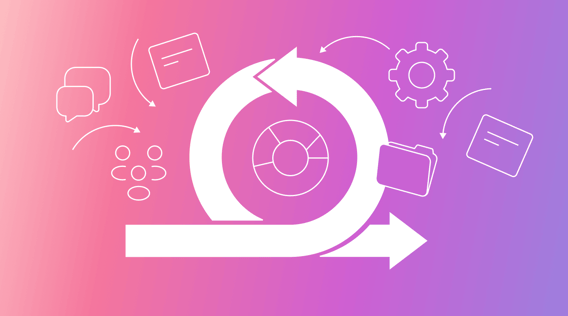Whether you’re already using Agile practices in your workflow or looking to learn more about Agile, you’ll likely have heard of the Agile Manifesto.
But what is the Agile Manifesto, and how can you use it to improve your Agile practice?
It’s a good question, and it’s no surprise you’re asking it. Some of the information out there can be pretty confusing, especially around a topic as nuanced as Agile.
The good news is that you’ve come to the right place for a simple, clear overview of the Agile Manifesto. In this article, we’ll explain the Agile Manifesto, its importance, and how to use it in your own Agile workflow.
What is the Agile Manifesto?
The Agile Manifesto is a comprehensive document that outlines Agile's core values and principles. In other words, it’s a document that helps you understand what Agile is and how it works.
The Manifesto was created in 2001 by a group of software industry professionals. They wanted a more flexible and collaborative approach to software development, so the Agile Manifesto came to life.
Although the Manifesto was written with software development in mind, it's not solely for the use of software development teams. In fact, the Agile principles apply to other areas, like project management or product development.
The Manifesto consists of four key values and twelve supporting principles. These areas emphasize the importance of customer collaboration, adaptability, early and frequent delivery, and the importance of individuals and interactions over processes and tools.
Let’s take a look at these areas in more detail.
What are the four core values of the Agile Manifesto?
There are four core values of the Agile Manifesto:
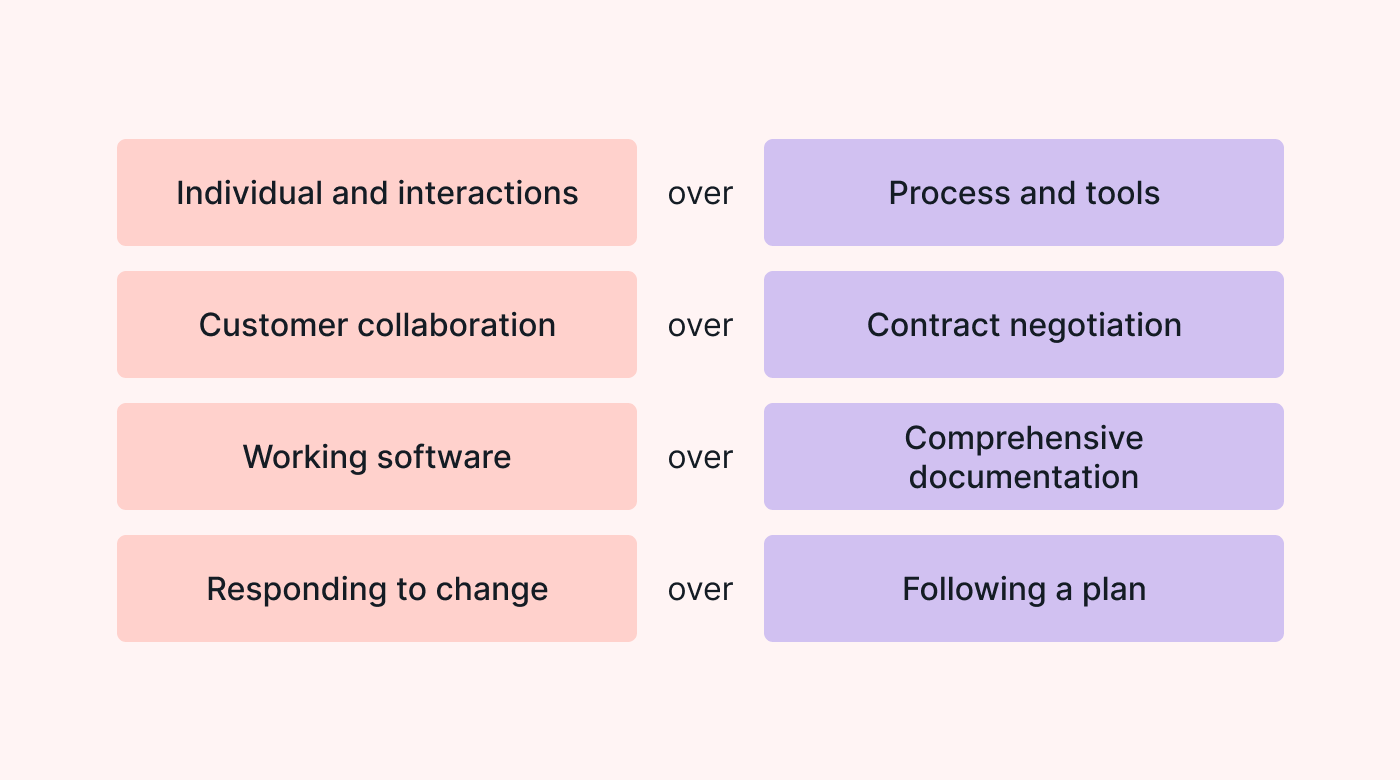 |
Let’s look at these in more detail.
- Individuals and interactions over processes and tools. This value recognizes that collaborative interactions, creativity, and teamwork are more valuable than rigid processes. It emphasizes the importance of people and effective communication within a development team, ensuring that Agile team members communicate clearly and often.
- Customer collaboration over contract negotiation. Agile requires communication and involvement from customers and stakeholders. This makes it easier for the development team to make sure that the final product meets the customer's needs and expectations.
- Working software over comprehensive documentation. This value means delivering software (the platform you use to launch new features, products, or services to your customers) is a bigger priority than creating documentation. Documentation is important, but the emphasis is on ensuring your software works so you can accurately measure progress and success.
- Responding to change over following a plan. Change is inevitable in Agile. Rather than strictly adhering to a predetermined plan, it requires the ability to adapt, respond, and embrace change quickly and effectively. This means using iterative development and continuous improvement to deliver the final software, product, or service. These continuous changes are based on customer feedback, stakeholders, and changing circumstances that impact your order of priorities.
Are there 12 principles in the Agile Manifesto?
Yes. Here's a brief overview of all the Agile principles:
- Provide customer satisfaction with early and continuous delivery of valuable software, features, services, and products.
- Be willing to adapt to changing requirements (even during the later stages of development).
- Prioritize shorter timescales to frequently deliver working products, services, and software.
- Collaborate with your Agile team members daily throughout the project.
- Allow team members to work independently, giving them the space to be self-sufficient and trusting them to get the job done.
- Use face-to-face conversation as the most efficient and effective method of communicating (this can be online if necessary).
- Measure progress by how well your products, services, and software features are working.
- Create sustainable processes so the Agile team can maintain a constant pace indefinitely.
- Have good attention to detail, focusing on technical excellence and good design to deliver the best results for your customers.
- Keep things simple in the Agile process to avoid overcomplicating your workload and making it hard for Agile teams to work in short sprints.
- Encourage self-organizing teams to organize their work and decide how to deliver the most value to customers.
- Reflect on how to adjust your Agile workflow to improve processes and help Agile team members communicate and collaborate effectively.
Why is the Agile Manifesto important?
Take a look at some of the reasons the Agile Manifesto is still used by businesses over 20 years after its creation.
It promotes customer satisfaction
The Manifesto puts customer value and satisfaction at the heart of everything. Whether you’re working on software development or project management, the Manifesto makes sure that you understand how important it is for customers to have a good experience.
Take a look at the first principle as an example:
Provide customer satisfaction with early and continuous delivery of valuable software, features, services, and products.
This focus on customer value helps you keep customers at the forefront of your mind when working through sprints. As a result, you’ll continually provide customers with valuable features, products, and services to boost their satisfaction.
It increases transparency and visibility
Agile projects often rely on visualizations (such as Kanban boards) to help everyone track their tasks and keep everyone on the same page. This transparency helps stakeholders understand project status, identify bottlenecks, and make informed decisions based on real-time information.
If you use an online, collaborative platform like Motion, it’s even easier for Agile teams to have total visibility of work. With our shared calendar, everyone on the Agile team can see their team members' schedules.
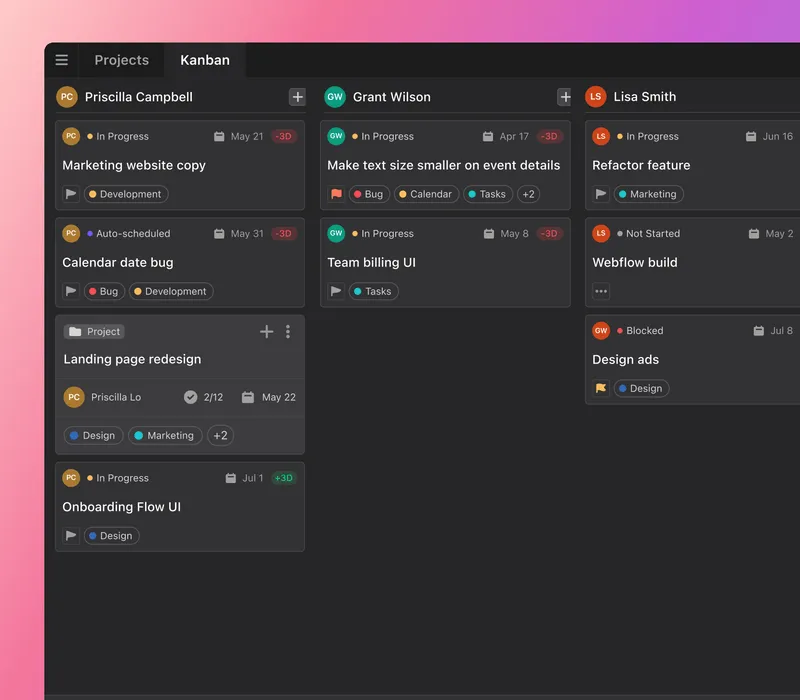 |
This makes it easier for teams to keep up to date with how tasks are progressing and keeps everyone accountable for their work.
To be more adaptable
The Agile Manifesto is big on being flexible. After all, without flexibility, you won’t be able to adapt your workloads to deliver the most value to customers in the least amount of time.
It also recognizes the inherent uncertainty and change in projects. Even when you plan your work down to a tee, unexpected hurdles and changes can crop up. If you can’t adapt, your entire project plan takes a hit.
With Agile, teams embrace change and adapt quickly to new requirements, technology advancements, and market shifts. This adaptability helps teams stay responsive in dynamic environments, helping them stay afloat and continue working towards a common goal.
How to use the Agile Manifesto
Here are some ways you can take an Agile approach to your work.
Embrace the Agile values and principles
The first step is to familiarize yourself and your team with the four core values of the Agile Manifesto. This also means understanding the twelve principles behind these values and adopting them as guiding principles for your work.
Here’s how you can do this with your Agile team:
- Share the Manifesto with your team. Start by sharing the Manifesto with your team so they can review it and understand what it means, how it works, and how it’ll feed into your way of working.
- Host a meeting with your Agile team. Get together with your team to discuss the principles as a group. This will give everyone a chance to ask questions and make sure they all understand how it works and what it’ll look like in your workflow.
- Incorporate Agile values and principles into your work. Now that everyone understands the Agile values and principles, it’s time to incorporate them into your work. This means using iterations, prioritizing communication and collaboration, and making sure that customer satisfaction is top of the priority list.
Use the right software
Using the right software can make it much easier to embrace Agile values.
If you use a platform that makes it hard to rearrange your tasks, you’ll struggle to keep on top of the changing requirements in your Agile project.
You need to find tools and platforms that enable Agile work and that allow you and your team to communicate and collaborate throughout the process.
Take a look at Motion as an example.
With our software, Agile teams can rearrange tasks in their calendar when priorities or requirements change.
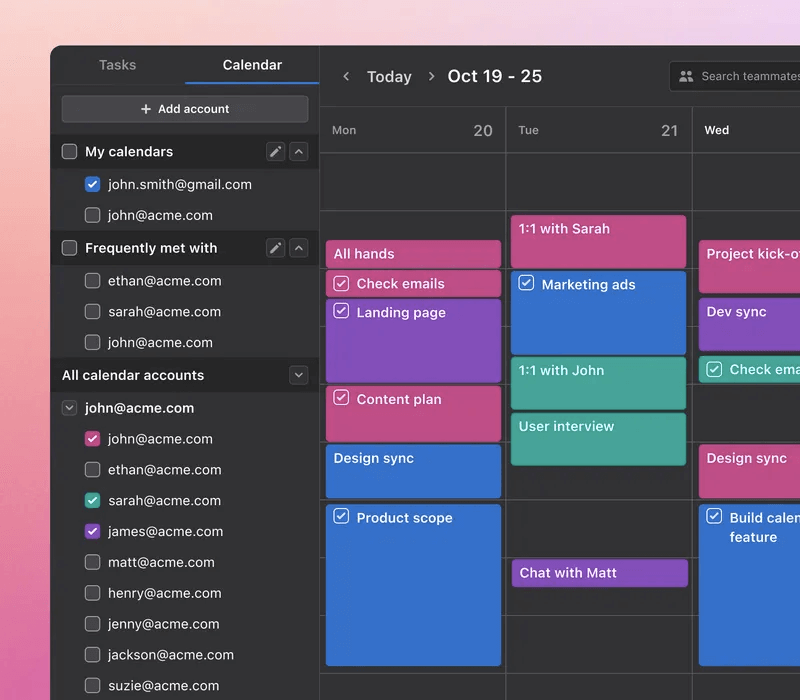 |
You can also assign priorities to certain tasks. When you rearrange your work, top-priority tasks will automatically take precedence over low-priority tasks. It saves you time and keeps your schedule aligned with your Agile goals.
Select an Agile framework
The Agile Manifesto applies to different Agile frameworks like Scrum, Kanban, and Lean.
To maximize the principles of Agile, it helps to choose one of these frameworks best suited to your project.
Here’s a description of each of these frameworks to help you decide which is right for you:
Scrum
The Scrum framework is a flexible Agile framework, dividing work into small blocks of work known as sprints. These sprints usually last around one week (although they can be longer or shorter). At the end of every sprint, the Agile team re-evaluates priorities to make sure the next sprint delivers the most value to customers.
Team members also have specific roles in the Scrum framework, including the Scrum master, product owner, and development team. All of these roles are responsible for different elements of the sprint, although some of their responsibilities overlap.
The Scrum process has specific events (known as ceremonies) which happen in the same order every time. For example, the team meets every day (during the daily stand-up meeting) to review progress and make sure they’re on track to hit the sprint goal.
Kanban
In the Kanban framework, tasks move through columns left to right, each of which represents a stage of work.
For example, tasks that are yet to begin would sit in the leftmost ‘to do’ column, while work that’s underway would be in the ‘in progress’ column.
You can choose how many columns you have — it depends on what your workflow looks like and how many steps you’ll need to complete your Agile project.
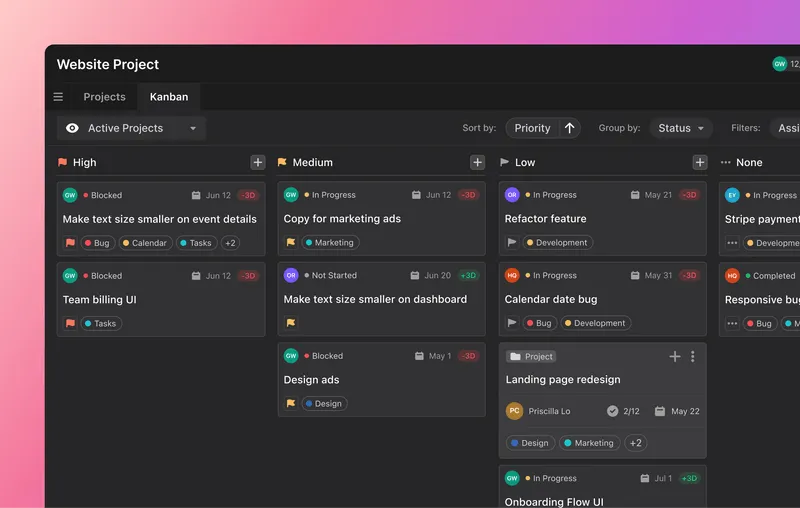 |
Another key element of Kanban is limiting work in progress. You can set limitations on each column to prevent overloading your team with tasks.
Kanban is also a good structure for getting a clear and transparent view of tasks. In a Kanban board, you can instantly see how the work is progressing and whether there are any bottlenecks to address.
Read this article to find out more about whether Kanban or Scrum is right for your project.
Lean
The Lean framework originates from manufacturing, but it’s a useful process for other areas of business, including project management, software development, and product development.
The process combines Lean principles (which focus on minimizing waste, optimizing resources, and improving efficiency) with Agile practices. As a result, Agile teams can make their processes as efficient as possible.
The Lean framework focuses on delivering customer value and promotes continuous improvement. Plus, it encourages cross-functional collaboration to help teams adapt, deliver high-quality products, and meet customer needs.
Continually iterate and improve
Continuously refining your processes is key to the Agile process. This means reflecting on your team's performance, identifying areas for improvement, and making adjustments. You should also incorporate feedback from stakeholders to improve future sprints.
For example, let’s say you’re using the Scrum framework. During your sprint review, customers tell you how to improve a specific feature.
You can incorporate this into your next product backlog (which is a prioritized list of tasks for your project). Then, you can figure out which items to add to your sprint backlog for your next block of work.
As a result, you’ll keep delivering value to customers in short timeframes. This means they’ll get a better experience and you’ll be more attuned to what they want from your product, service, or software.
Manage your Agile workflow with Motion
The Agile Manifesto is a helpful guide for Agile teams. It helps you understand the purpose of Agile and how to use it in your projects. Without it, you might lose sight of what you’re trying to achieve and how you want your Agile team to work.
To help you manage the Agile process, take a look at Motion. Our AI-powered calendar makes it easy for Agile teams to plan their sprints, reshuffle tasks, and keep the top-priority tasks at the forefront of your schedule.
Sign up for a free trial to get started.

